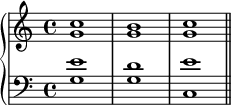Second inversion

The second
4 chord (as in I6
4), while a second-inversion seventh chord is a 4
3 chord.
Inversions are not restricted to the same number of tones as the original chord, nor to any fixed order of tones except with regard to the interval between the root, or its octave, and the bass note, hence, great variety results.[1]
Note that any voicing above the bass is allowed. A second inversion chord must have the fifth
Examples
In the second inversion of a C-
In the second inversion of a G dominant seventh chord, the bass note is D, the fifth of the seventh chord.
Types
There are four types of second-inversion chords:
Cadential
4-V-I, or one of its variation, like I6
4-V 7-I. In this form, the chord is sometimes referred to as a cadential 6
4 chord. The chord preceding I6
4 is most often a chord that would introduce V as a weak to strong progression, for example, making -II-V into II-I6
4-V or making IV-V into IV-I6
4-V.
The cadential 6
4 can be analyzed in two ways: the first labels it as a second-inversion chord, while the second treats it instead as part of a horizontal progression involving voice leading above a stationary bass.
- In the first designation, the cadential 6
4 chord features the progression: I6
4-V-I. Most older harmony textbooks use this label, and it can be traced back to the early 19th century.[2] - In the second designation, this chord is not considered an inversion of a tonic triadsuspension. Several modern textbooks prefer this conception of the cadential 6
4, which can also be traced back to the early 19th century.[5]
Passing
In a progression with a passing second-inversion chord, the bass passes between two tones a third apart (usually of the same
Auxiliary (or pedal)
In a progression with an auxiliary (or pedal) second-inversion chord, the IV6
4 chord functions as the harmonization of a
4-I. In this progression, the third and fifth rise a step each and then fall back, creating a harmonization for the scale degrees
Bass arpeggiation
In this progression, the bass arpeggiates the root, third, and fifth of the chord. This is just a florid movement but since the fifth is present in the bass, it is referred to as a bass arpeggiation flavour of the second inversion.[citation needed]
See also
- Root position
- First inversion
- Third inversion
- Fourth inversion
References
- ^ Hubbard, William Lines (1908). The American History and Encyclopedia of Music, Vol. 10: Musical Dictionary, p.103. Irving Squire: London. [ISBN unspecified]. Also at the HathiTrust Digital Library
- ^ Weber, Theory of musical composition, p. 350, quoted in Beach, D (1967) "The functions of the six-four chord in tonal music", Journal of Music Theory, 11(1), p. 8
- LCC MT50 A444 1989.
- ISBN 0-03-077495-0.
- ISBN 0-486-43188-6. quoted in Beach, David (1967). "The functions of the six-four chord in tonal music", p.7, Journal of Music Theory, 11(1).
- ^ ISBN 0-393-97666-1
Further reading
- Walter Piston, Harmony[full citation needed]
- Aldwell and Schachter, Harmony and Voice Leading, 3rd Edition[full citation needed]










